You can maintain balance and prevent falls by starting with simple weight shifts and single-leg stands, holding each position for 30 seconds. Transform daily walks into balance training by adding heel-to-toe movements and practice standing kicks while holding a sturdy surface. Strengthen your core with planks, explore gentle Tai Chi classes, and maintain proper posture with a fixed gaze ahead. These foundational techniques will prepare you for more advanced balance strategies ahead.
Start With Simple Weight Shifts and Single-Leg Stands
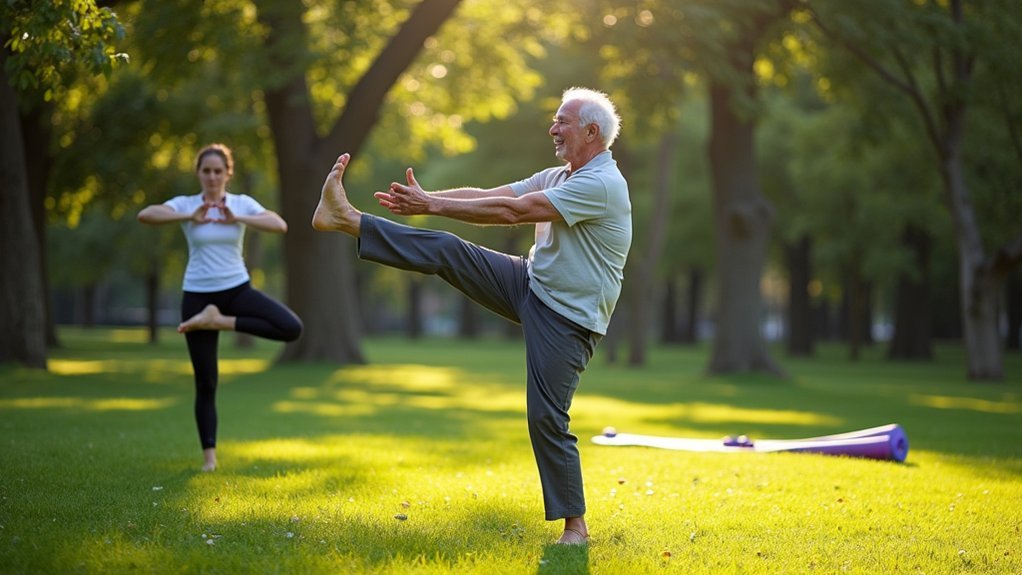
When you’re beginning your balance training journey, weight shifts and single-leg stands serve as the perfect foundation exercises that don’t require equipment or extensive space.
These balance exercises are remarkably simple yet effective for enhancing stability and coordination.
For weight shifts, stand with feet hip-width apart, then shift your weight to one side while lifting the opposite foot. Hold this position for up to 30 seconds.
Single-leg stands involve lifting one leg completely off the ground while maintaining balance on the other foot, also holding for 30 seconds.
Start with fewer repetitions if you’re a beginner, gradually increasing as you improve your balance.
Regular practice of these exercises enhances proprioception, reducing fall risk while building essential muscle strength for injury-free aging.
Incorporate Daily Walking and Heel-to-Toe Movements
Building on your foundation of stationary balance exercises, you can now expand your training by incorporating movement-based activities that challenge your stability in dynamic ways.
Daily walking transforms into powerful balance training when you’re intentional about your approach. Add heel-to-toe movements to your daily routine by placing each heel directly in front of your other foot’s toes. This technique strengthens coordination muscles and improves posture while challenging your balance system.
Aim for 150 minutes of moderate walking weekly, including these specialized movements. These balance exercises reduce your risk of falls while boosting your physical health.
Beyond strengthening your body, this combination supports mental functioning, enhancing memory and spatial cognition as you age.
Practice Standing Kicks and Sidestepping Exercises

While walking builds your foundational stability, standing kicks and sidestepping exercises target the precise muscle control needed for real-world balance challenges. These balance exercises engage stabilizing muscles that strength training alone can’t address.
Standing kicks involve balancing on one leg while extending the opposite leg forward, sideways, and backward. Start with multiple repetitions in each direction to progressively challenge your coordination. Your balance improves as you master these controlled movements.
For sidestepping, step sideways while facing a stable surface for support. This promotes essential lateral movement patterns that prevent falls during everyday activities.
- Use resistance bands around knees or ankles to increase difficulty
- Integrate both exercises into your regular fitness routine
- Focus on controlled movements rather than speed or height
Add Core Strengthening to Your Balance Routine
Standing kicks and sidestepping exercises work your extremities, but your core serves as the central powerhouse that controls all movement.
Core strengthening exercises like planks and seated leg lifts enhance stability, which is essential for maintaining balance as you age. A strong core supports proper posture, reducing your risk of falls and injuries, particularly as muscle atrophy becomes more common.
Incorporating core exercises into your balance training improves overall body control, contributing to better coordination during daily activities.
Research shows that engaging in core strengthening activities can enhance balance performance by up to 30%, considerably reducing fall risk for older adults.
Regular core workouts, combined with balance training, help maintain independence and enhance your quality of life.
Use Support When Beginning Balance Board Training
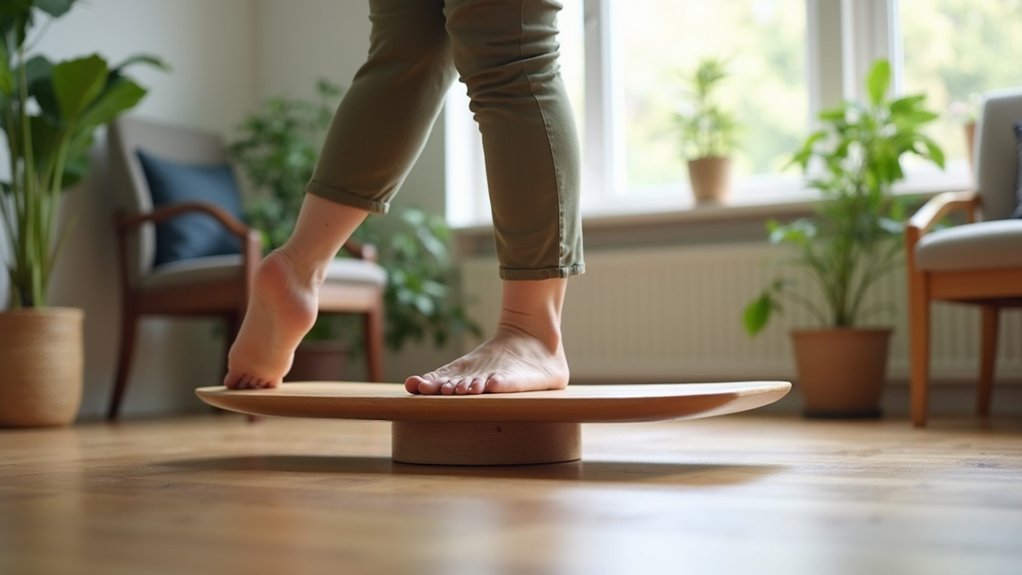
Although balance boards offer excellent training benefits, you’ll want to position yourself near a sturdy wall or chair when you first begin. This support prevents falls and builds confidence as you develop new stability skills.
Start with basic movements while maintaining contact with your chosen support structure:
- Practice simple forward and backward tilts while holding onto the wall or chair
- Keep your gaze focused on a fixed point ahead to enhance stability
- Maintain proper posture throughout each movement to maximize training benefits
As your balance improves, gradually reduce your reliance on external support.
Remember to consult your healthcare provider before starting balance board training, especially if you have existing health conditions. This precautionary step guarantees you’re ready for this type of stability work.
Combine Bicep Curls With Single-Leg Balance
You’ll maximize the benefits of this dual-purpose exercise by mastering three key elements that work together to build both strength and stability.
First, establish the proper starting position with your feet hip-width apart while holding a dumbbell in one hand.
Then focus on smooth execution technique as you lift the opposite leg and perform controlled bicep curls, before progressing to more challenging variations as your balance improves.
Proper Starting Position
Foundation matters when combining bicep curls with single-leg balance work. Your proper starting position sets you up for success and reduces injury risk. Balance exercises can help improve stability while building strength simultaneously.
Begin with these essential positioning steps:
- Stand with feet hip-width apart, distributing weight evenly on both legs before lifting one foot off the floor.
- Hold your dumbbell in one hand while lifting the opposite leg, bending it back at the knee.
- Engage your core muscles and maintain good posture with shoulders back and down.
Keep your gaze fixed ahead to enhance focus during the movement. A physical therapist often recommends starting with lighter weights until your balance improves.
This proper starting position guarantees you’ll maximize benefits while minimizing fall risk as you age.
Exercise Execution Technique
Once you’ve established your proper starting position, begin the movement by slowly curling the dumbbell toward your shoulder while maintaining balance on your standing leg. Keep your core engaged and maintain a fixed gaze ahead to prevent balance problems during execution.
Perform each curl for 30 seconds, focusing on controlled movements rather than speed. Your standing knee should remain slightly bent to avoid hyperextension and enhance stability throughout the motion.
This dual-purpose technique builds muscle strength while simultaneously challenging your balance system. As your coordination improves, gradually increase the weight or repetitions.
Physical therapy principles support this approach, as combining upper body resistance training with balance challenges creates an effective exercise program that addresses multiple aspects of injury prevention and functional movement patterns essential for healthy aging.
Progressive Difficulty Adjustments
Mastering the basic bicep curl with single-leg stance opens the door to more challenging variations that’ll accelerate your balance improvements.
As your stability and strength develop, you’ll want to progressively increase the difficulty to prevent plateaus and continue building the coordination needed to avoid falls.
Your progression strategy should include:
- Weight advancement – Gradually increase dumbbell weight as your form remains solid and controlled
- Volume increases – Add more repetitions beyond the initial 5-10 range when exercises feel manageable
- Side consistency – Always alternate between legs to guarantee balanced strength development across your body
These adjustments challenge your neuromuscular system while building the functional strength essential for injury-free aging.
Explore Tai Chi for Gentle Movement Training
You’ll discover that Tai Chi offers exceptional balance benefits through its slow, controlled movements that enhance stability and reduce fall risk by up to 40%.
This gentle practice improves your coordination, flexibility, and body awareness while providing additional mental health benefits like stress reduction.
You can easily find Tai Chi classes at local fitness centers, senior communities, or through qualified instructors who’ll guarantee you learn proper techniques for maximum safety and effectiveness.
Tai Chi Balance Benefits
While many exercise programs can feel intimidating or overly strenuous for older adults, Tai Chi offers a revitalizing gentle approach to building the balance and stability you need for injury-free aging.
This ancient practice delivers remarkable health benefits through slow, controlled movements that strengthen your coordination while reducing your risk of falling by up to 40%. The gentle nature of Tai Chi makes it accessible regardless of your current fitness level.
Key advantages include:
- Enhanced balance and stability through improved coordination and strength
- Better mental focus and spatial cognition from mindful movement practice
- Social interaction opportunities in supportive group class environments
You’ll find qualified instructors at fitness and senior centers who’ll guarantee you’re executing movements correctly, maximizing your balance improvements and overall wellness benefits.
Finding Classes and Resources
Since Tai Chi’s gentle approach makes it perfect for building balance and preventing falls, you’ll want to explore the various class options and resources available in your community. Many community centers and fitness facilities offer senior-specific Tai Chi classes that combine physical activity with social engagement.
| Option | Benefits |
|---|---|
| Community Center Classes | Social connection + expert guidance |
| Fitness Facility Programs | Professional instruction + convenient scheduling |
| Qualified Instructors | Proper technique + maximum stability gains |
| Online Videos | Home practice + flexible timing |
| Instructional Books | Self-directed learning + reference material |
You’ll find that qualified instructors guarantee proper movement execution, maximizing your balance improvements. If you prefer practicing at home, online resources and instructional books provide excellent alternatives for self-directed learning while still achieving enhanced coordination and overall quality of life.
Maintain Proper Posture and Fixed Gaze During Exercises
When you maintain proper posture during balance exercises, you’re creating a stable foundation that enhances your body’s natural alignment and reduces injury risk.
Keep your back straight, shoulders relaxed, and core engaged to maximize stability throughout each movement.
Proper alignment with engaged core muscles creates the foundation for safe, effective balance training and injury prevention.
Your gaze plays an equally important role in balance training. Fix your eyes on a point directly ahead to improve focus and maintain your center of gravity.
This technique minimizes distractions while supporting proper body alignment.
Key elements for effective balance work include:
- Engage your core muscles throughout each exercise to support spinal alignment
- Practice focused breathing while maintaining your fixed gaze point
- Start slowly and gradually increase difficulty as your posture and stability improve
Regular attention to these fundamentals will enhance your health outcomes and reduce fall risk as you age.
Build Muscle Strength to Combat Age-Related Decline
You’ll face inevitable muscle loss starting around age 30, but resistance training can help you fight back against this decline.
Building strength through targeted exercises at least twice weekly won’t just maintain your muscle mass—it’ll actively combat sarcopenia and improve your balance.
When you combine proper resistance work with adequate protein intake, you’re creating a powerful defense system against age-related weakness that threatens your independence.
Resistance Training Benefits
Starting in your 30s, your body begins losing muscle mass at an alarming rate—up to 50% by age 70 if left unchecked.
Resistance training serves as your most powerful weapon against this decline, offering dramatic benefits that extend far beyond muscle appearance.
Regular resistance exercises deliver remarkable results for older adults:
- Strength gains of 20-40% – dramatically improving your ability to perform daily activities independently
- Enhanced balance and coordination – helping you lower the risk of dangerous falls that can sideline your active lifestyle
- Improved bone density and metabolism – creating a foundation for long-term health and wellness
The American College of Sports Medicine recommends targeting major muscle groups twice weekly.
This investment in resistance training preserves your muscle mass and strength while maintaining the independence you value most.
Sarcopenia Prevention Strategies
Though sarcopenia affects millions of adults worldwide, you can take decisive action to prevent and reverse this muscle-wasting condition. Starting as early as age 30, you’ll experience gradual strength decline that accelerates over time, potentially losing 50% of muscle mass by age 70.
| Strategy | Frequency | Key Benefits |
|---|---|---|
| Resistance Training | 2-3x weekly | Combat muscle loss, improve strength |
| Protein Intake | Daily | Support muscle maintenance (1.2-2.0g/kg bodyweight) |
| Balance Exercises | 3-4x weekly | Enhance stability, reduce fall risk |
You can dramatically improve your outcomes by combining strength training with adequate nutrition. Regular physical activity through weight lifting, bodyweight exercises, tai chi, or yoga creates a thorough approach. This strategy doesn’t just preserve muscle—it enhances your functional capacity and overall quality of life as you age.
Progress Gradually While Listening to Your Body
While your enthusiasm for improving balance is admirable, rushing into advanced exercises can backfire and increase your risk of falls or injury.
You’ll achieve better results by starting with foundational movements like weight shifts and single-leg stands. As your stability improves, you can gradually progress to more challenging balance exercises.
Your body’s signals are essential guidance throughout this process.
Here’s how to stay safe:
- Stop immediately if you experience dizziness, lightheadedness, or discomfort during any exercise
- Consult your healthcare provider before starting, especially if you have underlying medical conditions
- Incorporate short, daily sessions rather than exhausting long workouts that lead to fatigue
Frequently Asked Questions
What Is the Number 1 Exercise to Increase Balance in Seniors?
You’ll find single-leg balance is the top exercise for improving balance. Stand with feet hip-width apart, lift one leg, and hold for thirty seconds while maintaining good posture and engaging your stabilizing muscles.
How to Maintain Good Balance as You Age?
You’ll maintain good balance by practicing tai chi or chair yoga 150 minutes weekly, doing single-leg stands and heel-to-toe walks regularly, plus adding strength training to counteract muscle loss.
What Are the Best Exercises for Stability, Balance, and Strength as I Age?
You’ll benefit most from Tai Chi, chair yoga, and single-leg stands for balance. Add bicep curls and weight shifts for strength. Include heel-to-toe walking and aim for 150 minutes of weekly activity.
How Can You Improve the Gait and Balance Function in the Elderly?
You’ll improve gait and balance by practicing tai chi, single-leg stands, and heel-to-toe walking daily. Add resistance training to fight muscle loss, and consider consulting a physical therapist for personalized exercises.
In Summary
You’ve got the tools to maintain your balance and prevent falls as you age. Start with simple exercises and gradually build complexity while listening to your body’s signals. Consistency matters more than perfection—even small daily efforts will strengthen your stability over time. Don’t rush the process, and always prioritize safety by using support when needed. Your future self will thank you for taking these proactive steps toward injury-free aging today.


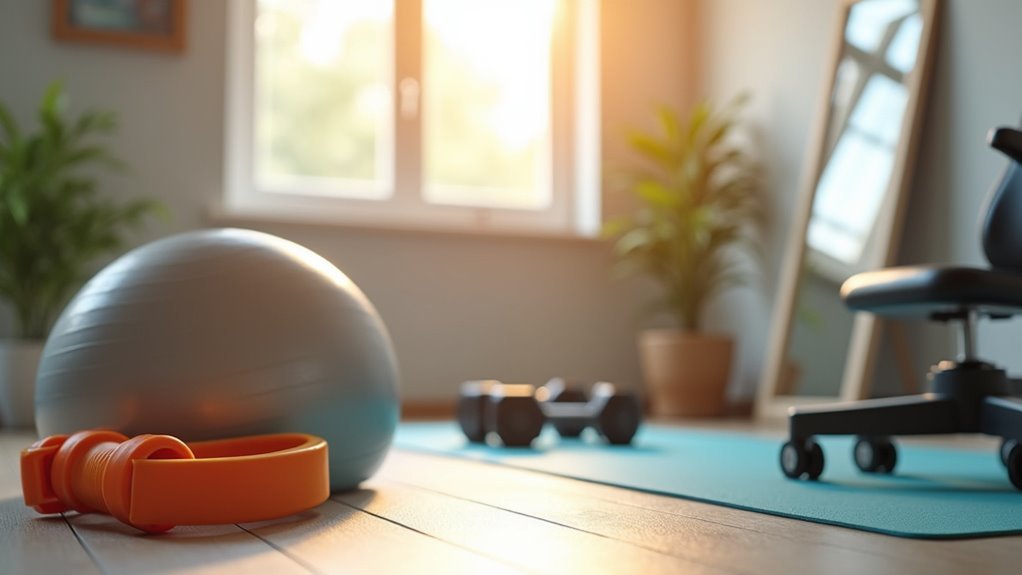
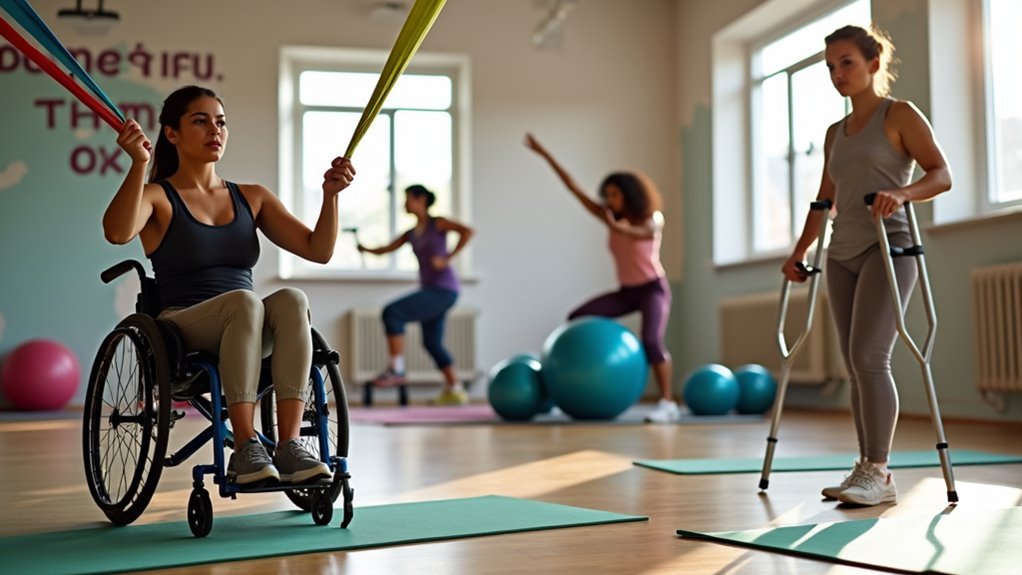
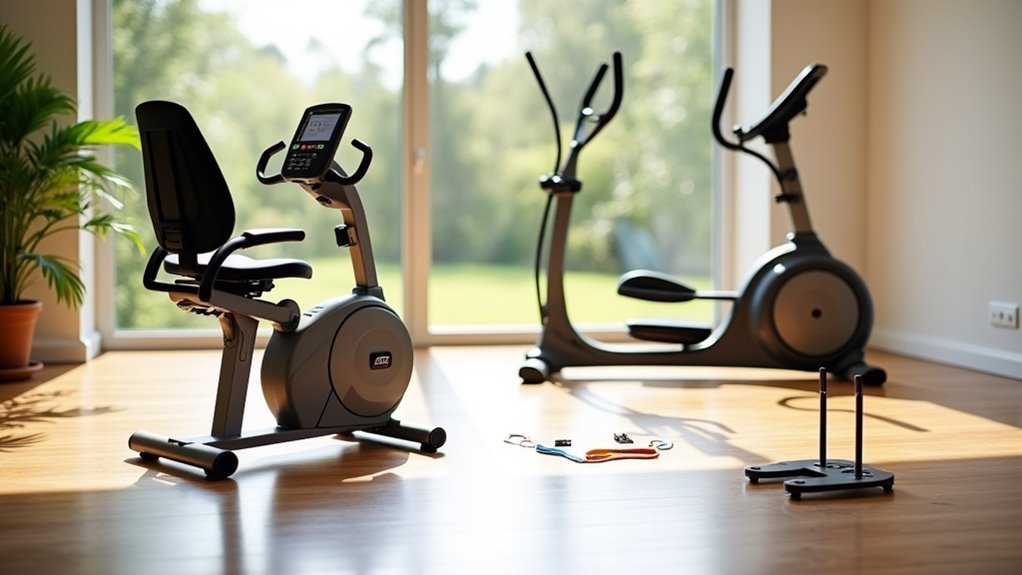
Leave a Reply